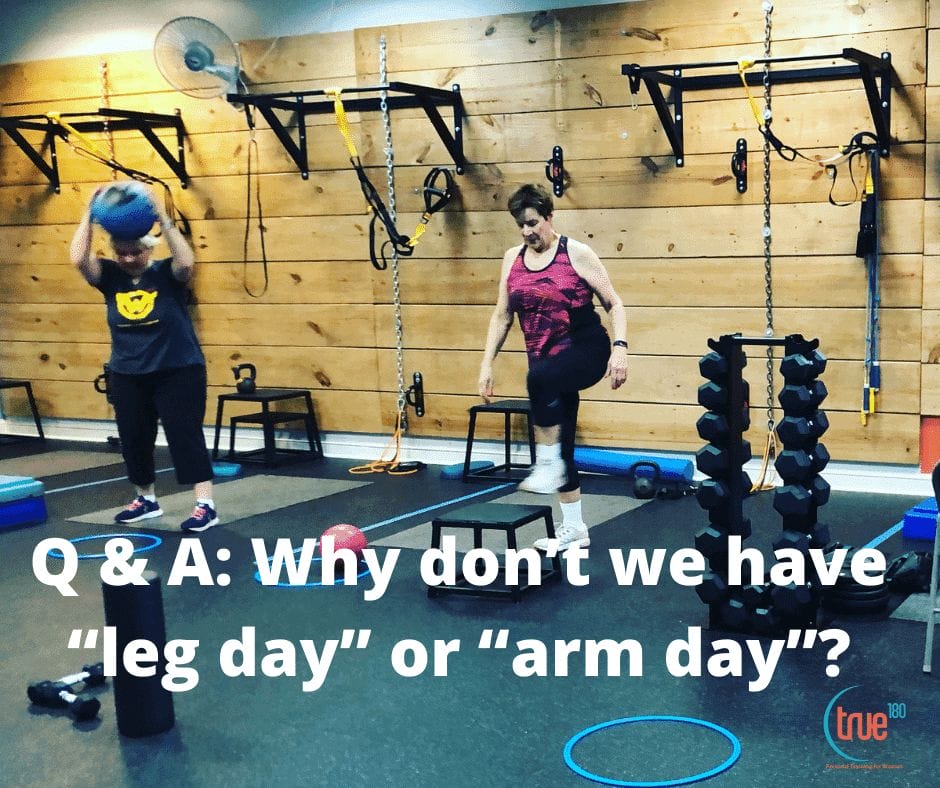Q: Why don’t we have a leg day or arm day?
A: Short answer is: The opposite of leg day or arm day is called total body training, and we use that because it’s time efficient, allows more flexibility, burns more calories, and has an even greater positive impact on your health.

Leg Day break down
When people have a chest day, leg day or arm day, they’re dividing their training up using a body part split. With a body part split you are trying to break your body up geographically and hit each with the greatest quantity (or volume) of exercise possible on one day. People tend to be able to do about 6-8 exercises with good (but diminishing) effort, so during each workout all 6-8 slots are focused on just 1-2 body parts, and need to be done 5-7 days per week.
Here’s an example of a week: Monday: 4 chest exercises and 3 triceps exercises, Tuesday: 4-5 back exercises and 3 biceps exercises… and so on Mon to Saturday, and you can’t move your workouts around because you need to hit each body part twice a week, and there aren’t enough days in the week to move things around. In other words, you have zero flexibility in your schedule.
Body builders, and others looking to get as big as possible do this because after drug use, gender, genetics, and age, it is the total volume of exercise per body part determines how big the muscles in that body part will get.
Our average client is a 52 woman who is not on performance enhancing drugs, and has a concern for her muscle mass, but is not primarily concerned with getting as big as possible.
Total Body Training
Total body training allows you to consistently train everything with balance. We cover all the bases each time.
Frequency: The average client trains 2 times per week, so if we split her body up into halfs, then we’d fall short of ever stimulating her muscles twice a week, and whenever she missed a workout (cuz life) then we’d miss half her body that week.
Balance: People tend to skip the day they don’t like, which is also the day that is the hardest for them, which is another way of saying people skip what they need most. Total body training avoids the possibility of being able to consistently skip your weakest/most effortful link because you give it some attention every time.
Intensity: We get tired as the workout goes, and your body parts get exponentially more tired when they’re all you are training. In other words, your first bicep exercise will be great, and your third will be lackluster. However, if you spread those 3 exercises out over 3 separate days, you can work harder, burn more calories and get better results.
Soreness: Yes, you still get sore with total body training. However, the soreness of 2 leg exercises pales in contrast with the agony of doing 6 leg exercises on the same day.
Metabolic health: Being able to properly regulate your blood sugar (closely related to insulin sensitivity) is at the heart of metabolic health. Metabolic health being prevention or control of cholesterol, triglycerides, diabetes, metabolic syndrome, blood pressure, etc.
Your muscles are your most important weapon in the battle to attain or maintain metabolic health because they can take up glucose (blood sugar) without the need for insulin if they are/have recently worked hard. Total body training stimulates most, if not all, of the muscle mass in your body vs a smaller area as you would with a body part split.
Cognitive health: BDNF stands for brain derived neurotrophic factor, and seems to be important for the survival and maintenance of your brain cells… it’s good for and protects your brain and nervous system. Resistance training that hits your larger muscle groups (legs!) does more to increase BDNF than training smaller muscle groups (arms). Both are still positive, but training your lower body 2-4x/wk, as you would in total body training, will maximize your BDNF.
We hope you now have a greater understanding of why we program the way we do, for you and why don’t we have a leg day or arm day?
